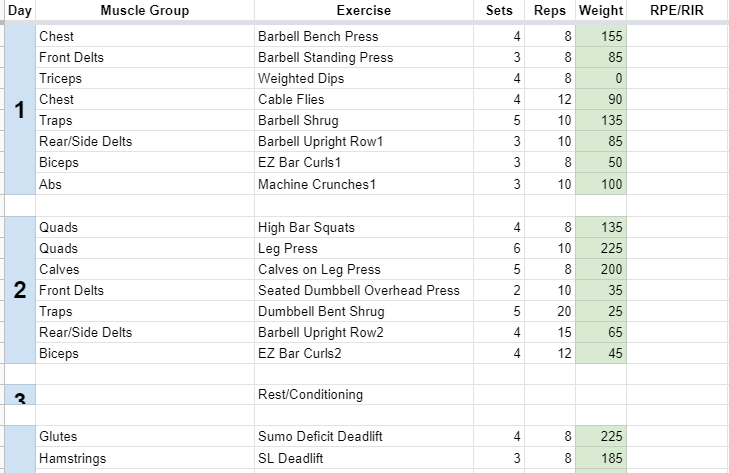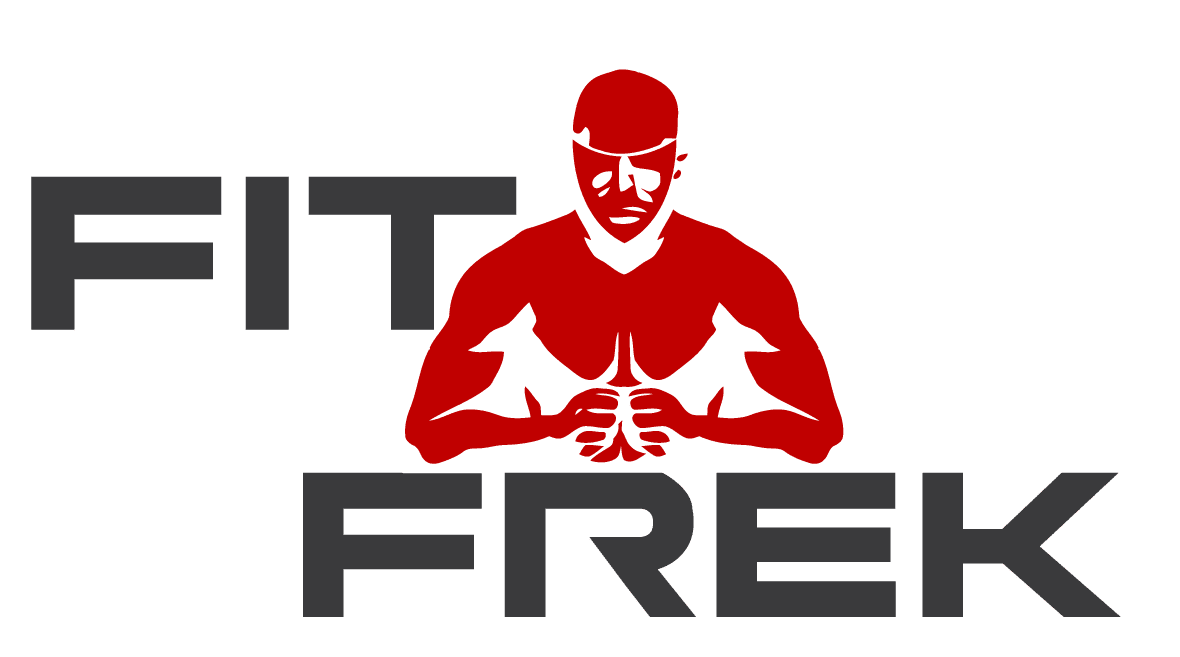

Dr. Mike Israetel is one of the most respected coaches in bodybuilding.
He has a PhD in Sport Physiology and he's behind this program; the Landmarks Hypertrophy Routine.
It's a 6 day hypertrophy that goes for 4 weeks and has a deload period on week 5.
The hypertrophy concepts goes in depth and Mike has an entire guide on this program. I recommend reading it.
To save the spreadsheet, please follow these instructions if you're on your mobile or desktop.
Dr. Israetel has a comprehensive guide that we recommend you read before starting this program.
He goes in depth and breaks down the program's principles.
There's 4 main volume training topics that he dives into which you'll see broken down below.
For the spreadsheet, you'll need to do some adjustments like choosing starting weights, and it'll also be important that you track your RPE (or RIR) per exercise so you can keep track of your training history to make adjustments for the future.
The Mike Israetel Hypertrophy Program is a scientifically-backed bodybuilding program designed to maximize muscle growth. It includes a detailed spreadsheet outlining the workout routine, sets, reps, and rest periods. The program lasts for 5 weeks and can be tailored to individual needs and goals.
This is a 6 day workout routine with 4 week runs and a week to deload after.
It's shared by LiftVault.com and it uses the recommendations made by Mike Israetel.
Here's the spreadsheet:
Dr. Mike Israetel Training Volume Landmarks Hypertrophy Routine
His volume recommendations are as follows:
How much volume needed to maintain your gains.
What's the least amount of volume required to increase gains
Range of volume that's optimal for gains. It can change from week to week
It's when you start hitting a plateau as the volume is too high and your recovery suffers.
These principles will allow the trainee to focus on the muscle group they want to develop the most.
This also allows the trainee to adjust according to their preferences as each trainee will have different MV, MEV, MAV, and MRV.
Understanding these variables for the trainee will allow them to understand their ideal volume numbers and this can change throughout the program.
This is how you'll find your training landmarks.
The volumes below will reference rep strength or performance…
Using RPE or reps in reserve, you can measure your rep strength or performance.
For example, say you did 4 sets of 12 reps with bench press with 135lbs and on the 4th set, you've felt you had 2 reps left in the tank, and then you repeated this same exercise and felt like you had 4-5 reps in the reserve in the final set, congratulations, you've increased performance.
You'll increase performance with any exercise that you're able to to decrease the RPE after a mesocycle.
It's recommended that you have at least 2-3 times per year where maintenance training and eating is done to “reset” your body to stimulus and growth.
Do this by following the MV volume recommendations laid out in the spreadsheet's “sets per weeks summary” tab in the spreadsheet or in the article by Dr. Mike.
If you find your rep strength was conserved at the end of the mesocycle at the volume recommended, then the volume was sufficient, then try lowering the number of sets to see if you can lower your MV in the next mesocycle.
If you found your rep strength lowered, volume wasn't sufficient and your MV is higher than the volume of work down from the last mesocycle, then increase the number of sets to see if rep strength can be maintained in the next mesocycle.
You'll want to keep your MV low as you can easily overestimate it.
Dr. Mike has two methods for finding minimum effective volume.
Method 1:
For one mesocycle, begin with recommended MEV that's noted in Mike's article or in the spreadsheet with the “sets per week summary” tab.
Each week, increase the weights but not the sets. Your performance on the main exercises should be tested at the end of the mesocycle.
If the volume of the last mesocycle met or exceed your MEV, then it improved.
Test by lowering volume by removing 2 sets each week and see if progress can continue.
Do this until you find a volume that doesn't increase performance, which then you would add 2 sets to the volume that didn't increase performance.
If your strength on a main exercise didn't improve and the volume was under your MEV, then add 2 sets per week until performance improves.
Method 2:
To see if a session was within your MEV, ask these questions:
Did you get a pump from the session?
Did the target muscles get challenged in the training session?
Did the session make you sore?
A score between 2 and 4 is probably going to be within your MEV, if you're:
Soreness is measured to help find your MAV.
To do this, you would need to add sets until soreness becomes overwhelming to the point where your performance suffers.
Here's how you can measure too much soreness and lowered performance:
No soreness = 1
Feel a bit sore or stiff but not sore by the time the next session on the same muscles comes = 2
Lots of DOMS (delayed onset muscle soreness) but disappeared just in time for the next muscle group's session = 3 points
DOMS are going into the next training session for that muscle group = 4 points
You had at least 2 reps left in reserve (RPE 7 or lower) = 1 point
You had 1 rep in reserve (RPE 8) = 2 points
You made all the reps with barely a single rep left in reserve (RPE 9/9.5) = 3 points
Some reps were missed or had lower performance compared to last week, accounting for different weights etc. =4 points
1+1 = 2 or 3 sets added to that exercise
Any 2's = 1 set added to that exercise
Any 3's = no sets added
Any 4's = take time to deload, lift light or take some days off
For warm up, it's a good idea to take 5-10 minutes to walk until you feel warm.
Once you do that, perform a few light sets of the muscles you're about to workout.
You should do at least 3-4 warm up sets before your actual workout, and then follow the program's workouts.
You can do 1-2 warm up sets before a specific exercise.
By paying attention to the signs that your body gives you, can prevent a burn out.
Here are some overtraining signs to look out for:
If you ignore these signs and keep exercising, you will eventually hit a plateau and will increase chance of injury.
If you're already experiencing these symptoms, take it easy and avoid pushing yourself for at least a week or two.
1. Who is Mike Israetel?
Mike Israetel is a professor of Exercise Science at the University of Missouri. He's a respected figure in the fitness industry, known for his scientific approach to bodybuilding.
2. What is the Mike Israetel Hypertrophy Program?
The Mike Israetel Hypertrophy Program is a bodybuilding program designed to maximize muscle growth. It includes a detailed spreadsheet outlining the workout routine, sets, reps, and rest periods.
3. How long does the program last?
The program is designed to be followed for a period of 5 weeks.
4. Do I need any special equipment to follow the program?
No, the program can be followed using standard gym equipment.
5. Can beginners follow this program?
While the program is designed with advanced lifters in mind, beginners can also follow it with some modifications.
6. How is the Mike Israetel Hypertrophy Program different from other bodybuilding programs?
The program stands out for its scientific approach to muscle growth. It's not just about lifting heavy weights, but understanding your body, knowing your limits, and pushing them in a structured, systematic way.
7. What results can I expect from the program?
Many users have reported significant gains in muscle size and strength after following the program. However, results can vary depending on individual factors like diet, rest, and consistency in following the program.
8. Is the program suitable for women?
Yes, the program can be followed by anyone looking to increase muscle size and strength, regardless of gender. However, women may need to adjust the weights used to suit their individual strength levels.
9. Do I need a gym membership to follow the program?
While the program can be followed using standard gym equipment, those with a well-equipped home gym can also follow the program.
10. Where can I find more information about the program?
For more information on the program, you can read Mike Israetel's articles on ResearchGate or check out user reviews and discussions on fitness forums.
Dr. Mike has used and incorporated multiple variables to help distinguish the needs of different lifters and trainees.
The Mike Israetel Hypertrophy Program is a well-structured, scientifically-backed approach to muscle growth.
This program is perfect for the advanced or intermediate trainee as it is complex and will help individuals progress using different factors.
If you have any questions or comments, please leave one below or contact me here.
Find your program through our program finder.
Useful Links
 About FitFrek
About FitFrekFitFrek operates as an independent platform, offering comprehensive workouts, programs, routines, guides, and unbiased reviews to accelerate your progress. We pride ourselves on our honesty, delivering straightforward and candid insights. FitFrek does not offer medical advice, diagnosis, or treatment services.